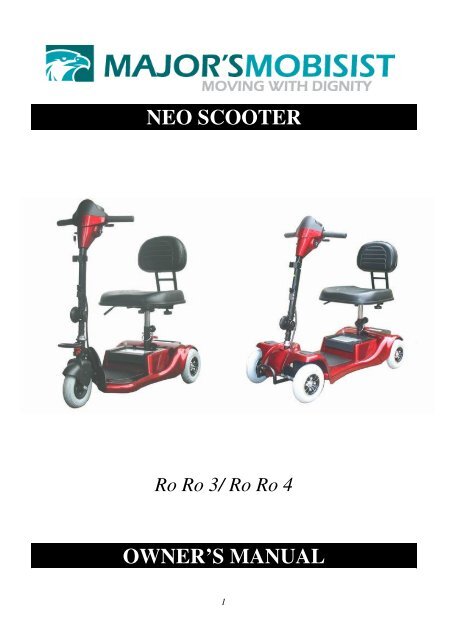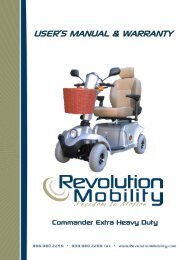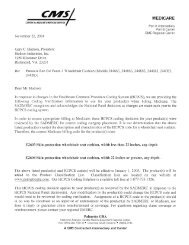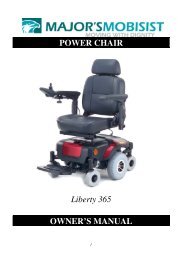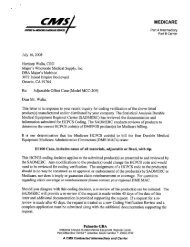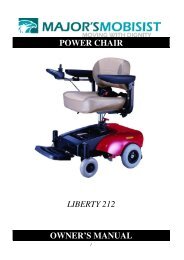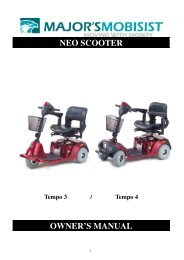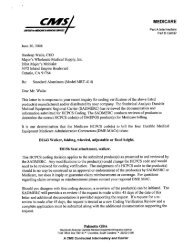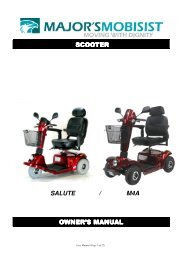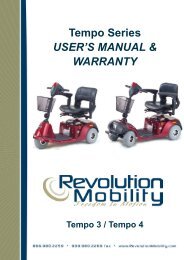NEO SCOOTER OWNER'S MANUAL - Revolution Mobility
NEO SCOOTER OWNER'S MANUAL - Revolution Mobility
NEO SCOOTER OWNER'S MANUAL - Revolution Mobility
- No tags were found...
You also want an ePaper? Increase the reach of your titles
YUMPU automatically turns print PDFs into web optimized ePapers that Google loves.
TABLE OF CONTENTS1. PREFACE AND INTRODUCTION ……..…………………………………… 22. SAFETY NOTICE…………………………………………………………...….2.1 Before driving2.2 While driving2.3 Labeling2.4 EMI33.4.PARTS INTRODUCTION……………..……………….. …………………….OPERATION…………………………………………………………………....4.1 Control panel4.2 How to operate your scooter4.3 How to set to freewheel mode895. DRIVING ON THE ROAD…………………………………………………….. 146. BATTERY CHARGING AND CARE……………………………………….....156.1 Charging the battery6.2 Battery6.3 Replacing batteries7. INSPECTION AND MAINTENANCE……………………………………..…7.1 Inspection7.2 Regular checking record7.3 Battery and tire7.4 Storage7.5 Moving about7.6 Disassembly7.7 Assembly8. TROUBLESHOOTING ……………………………..……………..………… 249. SPECIFICATION …………….………………………………………..……… 2510. WARRANTY…………………………………………………………………..... 26192
1 . P R E FAC E A N D I N T RO D U C T I O NPlease carefully read this owner’s manual before using the vehicle. Improper use of thevehicle could result in harm, injury or traffic accidents. To ensure that you get the mostyour scooter, please read this owner’s manual before using.♦ This owner’s manual includes operation instructions for every aspect of the vehicle,assembly instructions, as well as instructions for how to deal with possible accidents.♦ The symbols used in this manual are explained overleaf: Warning Attention SuggestionImproper usage could result in serious injury or deathImproper usage could lead to injury and/or damage to your scooter.Follow these instructions to keep your vehicle in a good operatingorder.♦ This manual includes a copy of repair and maintenance record chart and warrantyinformation. Please keep it in a safe place or in the scooter.♦ If someone else uses the scooter, please make sure that you provide him or her with thisowner’s handbook for his or her consideration.♦ As designs change some illustrations and pictures in the manual may not correspond tothe vehicle that you purchased. We reserve the right to make design modifications.Our Scooters have been designed and manufactured to provide a comfortable and secureyet affordable solution for some mobility requirements.3
2 . S AFETY N OT I CE2.1 BEFORE DRIVINGThe user needs to be familiar with the usage and operation of this vehicle before driving.Therefore, please follow the commendations in this safety notice.■ The same traffic rules apply to the use of this vehicle as apply to pedestrians♦ For your safety, please follow and adhere to the same traffic laws as pedestrians.♦ Please do not drive your scooter after consuming alcohol or when you are tired.♦ Please be careful when driving your scooter in low light. It has not been designed foruse at night.♦ Be extremely cautions when driving you scooter in busy areas or in shopping malls.♦ Ride on the pavement, single carriage roads, or pedestrian areas only. Never ride onmotorways or dual carriageways.♦ Be aware of traffic when crossing or using roads.■ Practice operating your vehicleBefore using the scooter in busy or potentially dangerous areas, familiarize yourself withthe operation of your scooter. Please practice in a wide and open area like a park. In orderto avoid accidents with your scooter whilst driving, please bear in mind driving motions,such as accelerating, stopping, turning, reversing, up-and down ramps.♦ Please turn the speed dial to minimum value for your initial practice.♦ Be sure someone accompanies you for safety when driving on the roads for the firsttime.♦ Only use higher speed setting when you are confident that you can easily operate andcontrol your scooter.■ The Scooter is only to be used by one person at a timeDo not carry passengers on your scooter (including children)■ Do not use this vehicle to carry or haul goods♦ The maximum weight that can be carried is 115kg/250lbs(including occupant and anygoods).Refer to “MAX LOAD WEIGHT” in “9. SPECIFICATION”♦ Maximum loading weight for basket is 3kg(7 lb).■ Please carry out daily inspections. Refer to the section entitled “DAILY CHECKING”4
2 . S AFETY N OT I CE2.3 LabelingFigure 1. Maximum Recommended Incline AnglesPlease carefully read all the labeling on the scooter before drive it. For your futurereminding, do not remove them .WARNING<strong>OWNER'S</strong> AND BATTERY OPERATING WARNINGexceed READ <strong>MANUAL</strong> motion. Never attempt to scooter the is tiller while the tightened. certain the tiller adjustment knob is fully Before lifting or driving the scooter make tiller adjustment knob. Please hold the tiller before loosening theCHARGE BEFOREDOWN FIRMLY for drive mode Always pull UP FIRMLY for freewheel mode OPERATION OF THE FREEWHEEL LEVER seated on the scooter on an incline! Never operate the freewheel lever while limits. weight recommended not Do push or inclinesWARNINGDisconnect BeforeSeparating FrameWARNINGWARNING:Radio waves may affect scooter control.Radio wave sources, such as radio stations, amateur radio (HAM) transmitters, two-way radios, andcellular phones, can affect powered motorized scooters. Following the warning listed below shouldreduce the chance of unintended brake release or powered scooter movement which could result inserious injury. .1. Do not turn ON hand-held personal communication devices, such as citizens band (CB) radios andcellular phones, while the powered scooter is turned ON.2. Be aware of near by transmitters, such as radio or TV stations, and try to avoid coming close to them.3. If unintended movement or brake release occurs, turn the powered scooter OFF as soon as it is safe.4. Be aware that adding accessories or components, or modifying the powered scooter, may make itmore susceptible to interference from radio wave sources. (Note: There is no easy way to evaluatetheir effect on powered scooter.)5. Report all incidents of unintended movement or brake release to the powered scooter manufacturer,and note whether there is a radio wave source nearby.6
2.4 EMI2. SAFETY NOTICEThis portion of the content will provide the user with basic information that describes theproblems with EMI, known sources of EMI, protective measures either to lessen thepossibility or exposure or to minimize the degree of exposure, and suggested actionshould unexpected or erratic movement occur.Caution: It is very important that you read this information regarding the possibleeffects of electromagnetic interference on your electric <strong>SCOOTER</strong>.■ ELECTROMAGNETIC INTERFERENCE (EMI) FROM RADIO WAVESOURCESPowered vehicle may be susceptible to electromagnetic interference (EMI), which isinterfering electromagnetic energy (EM) emitted from sources such as radio stations, TVstations, amateur radio (HAM) transmitters, two-way radios, and mobile phones. Theinterference (from radio wave sources) can cause the powered scooter to release itsbrakes, move by itself, or move in unintended directions. It can also permanently damagethe powered scooter’s control system. The intensity of the interfering EM energy can bemeasured in volts per meter (V/m). Each powered scooter can resist EMI up to a certainintensity. This is called its “immunity level”. The higher the immunity level, the greateris the protection. At this time, current technology is capable of achieving at least a 20V/m immunity level, which would provide useful protection from the more commonsources of radiated EMI. This powered scooter model as shipped, with no furthermodification, has an immunity level of 20 V/m without any accessories.There are a number of sources of relatively intense electromagnetic fields in the everydayenvironment. Some of these sources are obvious and easy to avoid. Others are notapparent and exposure is unavoidable. However, we believe that by following thewarning listed below, your risk to EMI will be minimized.The sources of radiated EMI can be broadly classified into three types:1. Hand-held portable transceivers ( transmitter -receivers with the antenna mounteddirectly on the transmitting unit. Examples include: citizens band (CB) radios,“ walkie talkie”, security, fire, and police transceivers, cellular telephones and otherpersonal communication devices.Note: Some mobile telephones and similar transmit signal while they are ON, evenwhen not being used;2. Medium-range mobile transceivers, such as those used in police cars, fire trucks,ambulances and taxis. These usually have the antenna mounted on the outside of thescooter.7
2. SAFETY NOTICE3. Long-range transmitters and transceivers, such as commercial broadcast transmitter(radio and TV broadcast antenna towers) and amateur (HAM) radios.Note: Other types of hand-held devices, such as cordless phones, laptop computers,AM/FM radios, TV sets, CD player, and cassette players, and small appliances, suchas electric shavers and hair dryers, so far as we know, are not likely to cause EMIproblems to your powered scooter.■ POWERED VEHICLE ELECTROMAGNETIC INTERFERENCE (EMI)Because EM energy rapidly becomes more intense as one moves closer to thetransmitting antenna (source), the EM fields from hand-held radio wave sources( transceivers ) are of special concern. It is possible to unintentionally bring high levelsof EM energy very close to the control system of power chair while using these devices.This can affect powered vehicle movement and braking. Therefore, the warnings listedbelow are recommended to prevent possible interference with the control system of thepowered scooter.■ WARNINGSElectromagnetic interference (EMI) from sources such as radio and TV stations,amateur radio (HAM) transmitters, two-way radios, and mobile phones can affectpowered scooter and motorized scooter. Following the warnings listed below shouldreduce the chance of unintended brake release or powered scooter movement whichcould result in serious injury.1. Do not operate hand-held transceivers-receivers), such as citizens band (CB) radios,or turn ON personal communication devices, such as cellular phones, while thepowered vehicle is turned ON;2. Be aware of nearby transmitters, such as radio or TV stations, and try to avoidcoming close to them;3. If unintended movement or brake release occurs, turn the powered vehicle OFF assoon as it is safe;4. Be aware that adding accessories or components, or modifying the powered vehicle,may make it more susceptible to EMI ( Note: There is no easy way to evaluatetheir effect on the overall immunity of the powered scooter).5. Report all incidents of unintended movement or brake release to the powered scootermanufacturer, and note whether there is a source of EMI nearby,■ IMPORTANT INFORMATION1. 20 Volts per meter ( V/m) is a generally achievable and useful immunity level againstEMI ( the higher the level, the greater the protection);2. This product has an immunity level of 20 V/m without any accessories and connectedto it.8
3 . PARTS INTRO DUCTIONPARTS DESCRIPTION1. Control panel 2. Basket3. Charger Socket 4. Tiller Adjustment Knob 5. Seat6. Seat Rotation Lever 7. Battery Pack 8. Freewheel Lever9. Anti-tip wheels 10.Seat Post Knob 11. Seat Height Adjustment Pin4 . O P E RAT I O N9
4.1 CONTROL PANEL1. Speed Dial 2. Horn Button3. Battery Indicator 4. Power Switch5. Power Eye4.2 HOW TO OPERATE YOUR <strong>SCOOTER</strong>■ Power switch♦ To switch the power on , turn the key clockwisein the ignition. The power eye should illuminate.♦ To switch the power off , turn the keyanticlockwise . The power eye should switch offand the key can be removed if required.■ Speed DialTurn the speed dial to determine the maximumspeed of the scooter. Turn the dial clockwise toincrease the speed setting and turn the dialanticlockwise to decrease the speed setting.Slowest settingfastest setting■ Moving and Braking♦ Push the right-hand side speed control lever forwards with your right thumb and thescooter will move forward.♦ Push the left-hand side speed control lever forwards with your left thumb and thescooter will move backward.♦ To brake , release the speed control lever which will return to neutral and activate theelectromagnetic brake automatically .This will bring the scooter to a prompt stop.♦ The speed control lever allows you to control the speed of the scooter up to amaximum speed determined by the Speed Dial .The further the speed control lever isdeflected, the faster the scooter will go.■ Horn ButtonPress the horn button to sound the horn. Release the button to stop the horn.■ BrakingElectro-magnetic brake: Release the speed control lever completely, and theelectromagnetic brake will be activated automatically, and the scooter will stop.10
4. OPERATION WarningWhen on a gradient NEVER set the vehicle to the freewheel mode. The electromagneticbrakes will not be applied. This may result in injury or damage.■ Seat♦ The seat can be rotated and locked in position at 45 degrees intervals.♦ Push the seat adjustment lever forward and swivel the seat.♦ Release the lever, and then continue swiveling the seat untilit locks in position. AttentionReturn the seat to the forward position before driving.■ Battery indicatorThe battery indicator on the tiller console usesa color code to indicate the approximate powerremaining in your batteries. Green indicates (40~100%) capacity, yellow a draining charge(10 ~30%),and red indicates that an immediate rechargeis necessary.♦ The remaining power suggested by the batteryindicator will vary by the actual driving timeincurred and how you drive. Repeated starting,stopping, climbing will consume the powermore quickly.REDYELLOWGREEN■ Main Circuit Breaker (Reset Button)When the voltage in your scooter’s batteries becomes low orthe scooter is heavily strained because of excessive loads orsteep inclines ,the main circuit breaker may tip to protect themotor and electronics from damage.♦ The main circuit breaker rest button pops out when thebreaker trips.♦ When the breaker trips , the entire electrical system of yourscooter shuts down.♦ Allow a minute or two for your scooter’s electronics to “rest”.♦ Push in the reset button to reset the main circuit breaker.11
4 . O P E RAT I O N Suggestion1. You should recharge the batteries after each time the vehicle is used to ensure maximumrange. The batteries should be charged up at least once a week even if the scooter is notused.2. After charging or replacing a new battery, drive the vehicle for 2-3 minutes to make surethe battery capacity is sufficient.3. In wintertime, the battery may respond more slowly and the battery range may bereduced.4. When driving on a gradient, the battery indicator light might move up and down. This isa normal phenomenon so please do not worry.5. Even if the battery is used properly, it is natural for the battery’s capacity to reduce withtime, which results in reduced battery range compared to a brand new battery. Therefore,when you find the battery’s range is about only 50% of the range when the batteries werenew, it is time to replace the batteries. Please see your dealer about replacementbatteries. If you continue to use the old battery when it should be replaced, it could leadto a rapid decline in performance.6. The battery range will be reduced when driving frequently on a slope or rough terrain, asthis leads to greater consumption of power.7. The batteries have a six-month warranty covering manufacturing defects. This warrantydoes not cover faults due to incorrect battery recharging.■ How to adjust the seat height1. Remove the seat from your scooter.2. Remove the pin lock from the lower seat post.3. Adjust the upper seat post to the desired seat height.4. Move the upper seat post so that there is a hole toinsert the locking pin.5. Insert the pin lock and replace seat replace seat.Pin lock12
4 . O P E RAT I O N4.3 How to set to freewheel modeLeverLeverFig 4.1 Fig 4.2◆ Engaged mode (Fig. 4.1): Push the lever completely and the scooter can be driven bymotor power.◆Freewheel Mode (Fig 4.2):Pull the lever up and the scooter can be moved manually. WarningNever operate the freewheel lever while seated on the scooter or on an incline!OPERATION OF THE FREEWHEEL LEVER‧ Always pull UP FIRMLY for freewheel mode‧ Always push DOWN FIRMLY for drive mode■ Tiller AdjustmentThe tiller can be adjusted in to many different positions to suit each driver.1. Loosen the knob to adjust the tiller to positions you want. (Fig. 4.3)2. Once decide the position, tighten the knob to secure the tiller.( Fig.4.4)AdjustmentknobFig. 4.3 Fig. 4.413
4 . O P E RAT I O N Warning♦ Please hold the tiller before loosening the tiller adjustment knob.♦ Before lifting or driving the scooter make certain the tiller adjustment knob is fullytightened.♦ Never attempt to adjust the tiller while the scooter is motion.14
5. DRIVING ON THE ROAD■ Starting and Driving1. Make sure the seat is installed properly.2. Make sure the tiller has been secured properly.3. Fold down the armrests so you can rest your arms on them.4. Turn the power switch to “ON”.5. Check battery indicator to see whether there is enough power for your journey. If youhave any doubt about the remaining power, please recharge the batteries beforedeparture.6. Set the speed dial to a position you feel safe and comfortable with.7. Check the forward/reverse speed lever works correctly.8. Make sure the electromagnetic brake works correctly.9. Before driving , ensure it is safe to do in the environment around you. Attention1. Do not push both RH & LH sides of the speed control lever simultaneously. This mightleave you unable to control your scooter.2. Do not turn the power switch to OFF while driving as this will lead to an emergencystop and possible risk of accident and injury.3. Do not set to the highest speeds whilst driving indoors.4. Do not adjust the speed dial whilst driving, a sudden change in speed may cause dangerto you and others, and may cause damage to your scooter.5. Do not place magnetic devices near the area of the operation handle as this could affectthe safe operation of your scooter. The scooter controller is located under the foot way.6. Do be careful whilst driving in heavy traffic or crowded areas.7. Whilst reversing the vehicle, beware of people or objects behind you.♦ Stopping1. Release the speed control lever completely. The vehicle will naturally brake and stop.2. Turn the power off. Then pull out the key. Attention1.The stopping distance will vary with your forward / reverse speed. Therefore pleasebegin braking as early as you can.2.When parking your scooter, be sure to park on flat ground and then turn the power to“OFF” before you dismount.15
6 . BAT T E RY CHARG I N G AND CARE6.1 CHARGING THE BATTERY■ Method 1: On board ChargingFollow the procedure below step by step:1. Turn the power switch to (OFF)2. Plug the charger’s power cord into the mains.3. Open the charging socket cap on the rear shroud. Thenconnect the charger’s round plug to the charging socket.4. Switch on the charger.5. Both the charger’s red and orange LED will be lit whenCharger socketbeginning charging. The charging duration is about 6 hours.To ensure optimum performance a 10-hour charge isrecommended.6. Both the charger’s LED will be lit during the chargingprocess. The orange LED will turn green when charging iscomplete.7. Turn off the charger, disconnect the power cord and the round plug from charger socketon the scooter.■ Method 2 Off-board Charging1. Turn the power switch to (OFF)2. Remove the battery pack by opening the batterycompartment and lifting out the battery pack by the handle.3. Plug the charger’s power cord into the mains.4. Plug the charger’s round plug into the charging socket ofPower Packthe battery pack.5. Switch on the charger.6. Both the charger’s red and orange LED will be lit whenbeginning charging. The charging duration is about 6 hours.To ensure optimum performance a 10-hour charge isrecommended.7. Both the charger’s LED will be lit during the charging process.The orange LED will turn green when charging is complete.8. Turn off the charger, disconnect the power cord and the roundplug from charger socket on the battery pack. Attention♦ While returning the battery pack to the battery pack cavity of shroud, beware of fingeror hands.Charger16
6 . BAT T E RY CHARG I N G AND CARE■ Charging HoursThe charging duration is about 6 hours. To ensure optimum performance a 10-hour chargeis recommended. But we do not recommend a charging more than 24 consecutive hours.■ Batteries (Inside the Pack)1. The RO RO/RO RO 4 is powered by two sealed lead-acid deep-cycle batteries.2. The batteries supplied with the scooter are 12 V 12ah batteries.3. Size : 5.94 “× 3.89 “ x 3.74 “ (Width x Height x Thickness)(151mm×99mm×95mm) Warning1. Keep away from flammable objects while charging as it may lead to fire or explosion ofbattery.2. Do not smoke while charging as the battery may release hydrogen gas. Always chargeyour battery in a well-ventilated space.3. Never connect or disconnect the plug or cord with wet hands while charging. Do notconnect or disconnect the plug or cord when they are wet, it may lead to electric shock. Attention - Please follow the rules below to avoid accidents while charging.1. Please use the WU’S charger only, and recharge the battery to its full capacity everytime. You may damage the battery and scooter if you use a charger, which is not tothe correct specification.2. Please charge in a well-ventilated space where it is not directly exposed to thesunlight. Do not charge in surroundings where it is humid or under rainfall andmorning dews.3. Do not charge in temperatures less than -10°C or higher than +50°C as the chargermay not work well and the batteries may become damaged.6.2 BATTERY♦ Do not expose the battery to temperatures below 10°C or above 50°C when charging orstoring the vehicle. Under the above temperature range can cause the battery either tofreeze or over heat. This will damage the batteries and shorten their life.♦ These batteries are maintenance free and there is no need to refill with water.♦ You are required to recharge the batteries on a regular basis. Even if the scooter is stoodidle, you should charge the batteries at least once a week.17
6 . BAT T E RY CHARG I N G AND CARE.♦ The batteries carry a six-month manufacturer's warranty. This warranty only coversissues relating to manufacturing faults, and not faults relating to failure to recharge thebatteries as instructed above. Suggestion – How to maximize your batteries efficiency and service life1. Fully recharge your new battery before its first time use.2. Be sure to charge the battery fully every time. The battery life will be seriouslyshortened or decayed if the battery is repeatedly used without being fully charged.3. Always complete the charging until the orange LED light turns green. NEVERstop charging before it is complete.4. Keep your batteries fully charged whenever possible.5. If you do not use your scooter for a long time, it should be charged at least everyweek to keep the battery in a fully usable condition.6. The ambient temperature will affect charging time. Charging time will be longerin the winter.7. After charging, do not leave the charger socket plugged in to the scooter, as thiswill cause a power drain on the scooter and temporarily reduce its range.■ Cleaning the batteryIf the batteries are contaminated by water, battery acid, dust or other substances, theywill discharge quickly. The batteries supplied with the scooter are sealed and as such aremaintenance free with no risk of battery leakage. Please follow the steps below to cleanthe battery.1. Turn the scooter power switch to OFF.2. Follow the procedure in the next section “Replacing the Batteries”.3. Use a clean cloth to wipe off the soiled area.4. Take out the battery.5. Clean the battery with a clean cloth. If the terminal is covered by white powder, pleasewipe it clean using warm water.6.3 REPLACING BATTERIES■ Batteries replacementFollow the procedure below step by step to replace the batteries:1. Remove the battery pack from the scooter.2. Open the battery pack then disconnect the cables from the four battery terminals.3. Remove the batteries from the battery pack.4. Place new batteries inside the pack.18
6 . BAT T E RY CHARG I N G AND CARE5. Connect the red cable to the positive(+) battery terminal and black cable to thenegative(-) on the other battery.6. Connect up the fused cable between the two batteries and close the battery pack.. Warning1. The wiring system and charger are well situated in the battery pack while beingassembled in plant. Do not attempt to re-locate the wiring system by yourself. Theimproper layout of wiring system may result in the wires pinched by battery box,which might result in the electronic system failure.2. Be sure the battery wires are connected to their right battery terminal. SuggestionsIf necessary, ask for help from your dealer for advice about maintaining and replacingthe battery. Suggestions1. Make sure the terminals are installed properly and put the cover back on.2. Do not use the battery to charge telecom equipment or other items.3. Battery efficiency will vary with outside conditions; the driving distances will beshorter in the winter. If the vehicle is not used for a long time, please charge thebattery at least every week.4. Replace both batteries together.19
7 . I N S P E CTION AND MAINTENANCE7.1 INSPECTION• Clean the scooter with a damp cloth and dust down approximately once a week topreserve the appearance of the scooter.• Adjust the tiller height and return to the original position and swivel the seat once aweek to ensure the parts adjust and remove smoothly and easily when required.• Check for signs of wear and tear on the tires and the upholstery on a regular basis.• For optimum performance and to increase the lifespan of your scooter, it isrecommended that you have your scooter serviced once a year.7.2 REGULAR CHECKING RECORDTo make sure your scooter is correctly serviced, take it to your dealer for regularmaintenance checks. This should be at six months intervals after an initial inspection afterone month. Your dealer may charge a fee for this. The checking record is shown overleaf.YEAR 1 2 3 4 YEAR 1 2 3 4Service DatesService DatesControllerUpholsteryOn/off switchSeatControl LeverBackBrakingArmrestsRecharge pointElectricsBatteriesConnectionsconditionLevelsHarnessConnectionsTest runDischarge testForwardsWheels and TiresReverseWearEmergency stopPressureLeft turnBearingsRight turnWheel nutsSlope testMotorsOver obstaclesWiringList Items repairedNoiseConnectionsBrakeBrushesChassisConditionSteering20
7 . I N S P E CTION AND MAINTENANCE7.3 BATTERY, FUSE AND TIRE■ BatteryRefer to the section entitled “6. BATTERY CHARGING AND CARE ”.■ FuseIf the battery charger is turned on and no LED are lit, check the fuse. SuggestionAsk for help from your dealer to inspect or replace the fuse, since the tiller shroud has tobe removed first before you can replace the fuse.■ TiresThe condition of the tires depends on how you drive and use your scooter.♦ Please check the tread depth regular.♦ Replace the tires when the tread depth is less than 0.5 mm. Attention1. When tread depth is below 0.5mm it can easily lead to vehicle slippage, makingbraking distances longer. Therefore replace the tyres as early as possible whenthey are found to have insufficient tread depth.2. The RO RO scooter comes with solid tyres so there is no need to check tyrepressure.7.4 STORAGEMake sure the scooter is stored under the following circumstances:- Ensure the seat is set in the “Forward” position- Ensure the scooter is switched off- Ensure the charger is disconnected when not in use SuggestionPlease store the scooter in a location where it is out of direct sunlight, rain, or dew. Whenstoring for a long time, please charge the battery to full power and then disconnect thebattery terminal. For details inquire to your dealer.21
7 . I N S P E CTION AND MAINTENANCE7.5 MOVING ABOUT♦ Switch off the power with power key before moving. Always dismount from thescooter before moving.♦ Lift the scooter by the chassis, and not by the shroud. Lifting the scooter by thebumper could cause damage or injury.♦ For your safety, always ask for help if required. You will need two people whenmoving or lifting the scooter whole. If you are on your own, please disassembly thescooter before lifting. Refer to the section below.7.6 DISASSEMBLING THE <strong>SCOOTER</strong>The RO RO 3/RO RO 4 can be disassembled in to four pieces, the seat (weight 6 kg), thefront section (weight 13.4 kg),the rear section (10.6 kg) and battery pack (weight 9.8 kg),without any tools. Please follow the steps.1. Push the Seat Rotate Lever whilst pulling up on the seat to remove.2. Open the battery compartment lid and lift out the battery pack.3. Loosen the tiller adjustment knob and fold down the tiller and retighten knob.4. Lock the front wheel and tiller by pulling the wheel lock catch down.5. Pull up the lever of lock bracket whilst pulling up the seat post rearward until the rearsection is standing vertically on the rear bumper.6. Lift the front section up until the lower pegs are longer in contact with the curvedlocking brackets on the rear section.RO RO 3Knob lock22
7 . I N S P E CTION AND MAINTENANCERO RO 4Knob LOCK WarningAlways unplug the rear section electrical connector before separating the two sections.23
7 . I N S P E CTION AND MAINTENANCE7.7 ASSEMBLING THE <strong>SCOOTER</strong> SuggestionThe assembly process is essentially the disassembly process in reverse. First study thetext and photographs in the disassembly procedure before re-assembling the scooter.1.Position the front and rear sections of RO RO 3/RO RO 4.2.Align the lower curved locking brackets of the front section withthe corresponding pegs on the front of the rear section.3.Holding the lower seat post, slowly pivot the rear section forward untilthe curved locking brackets are fully connected on to the top rear pegs.4.Loosen tiller adjustment knob, raise the tiller to the desired position, and then tighten thetiller adjustment knob.5.Reinstall the batteries by lowering it in to place.6.Replace the seat and rotate it until it locks into its correct position. WarningAfter assembling the RO RO 3/RO RO 4, make absolutely certain the tiller adjustmentknob is fully tightened.24
8 . T RO U BLESHOOT I N G■ TROUBLE SHOOTINGIf you have trouble with your scooter, you can inspect the following before taking youscooter to the dealer.If you cannot solve the problem, contact your dealer for assistance.Problem Symptom Remedy• Batteries not connected• Rear and frond sectionsnot connected• Circuit breaker has trippedThe scooter will notswitch onThe scooter switch onbut will not runScooter appears slowThe seat moves whilst inuseThe tiller appears looseInvoluntary horn sounds• Flat batteries• Charger plugged in• Motor in freewheel mode• Flat batteries• Speed setting slow• Seat note locked inposition• Tiller adjustment knobloose• There is fault on thescooter• Check batteries are connected• Check connection on front – to- rear loom• Push circuit breaker button torest• Check battery power• Unplug charger• Re-engage the freewheel lever• Check battery power and /orrecharge• Check the speed dial is not setat low• Slowly rotate the seat until itdrops in to place and is secure• Tighten the tiller adjustmentknob• Ensure the control lever isreleased and switch thescooter on and off rechargebatteries9 . S P E CIFICAT I O N25
S P E C I F I C AT I O N SModel RO RO 3 RO RO 4Dimension (L x W x H mm)(L x W x H inch)960x480x880 mm37.8 “x 18.9” x 34.6”1035x500x929 mm40.7 “x 19.6” x 36.6”Weight(Kg),W/I battery39.8 kg / 87.6 lb 45kg/99lbW/O battery 30kg / 66 lb 35.3kg/77.7lbBattery 12V 12 Ah x 2Charger24V 2AFront Tire200 x 50 solidRear Tire200 x 50 solidDriving SystemDirect rear wheels (with differential gear)Brake SystemElectromagnetic brakeControl MethodBy speed control leverTop Speed6.4km/hr / 4 mphClimbing angle 6°- 8°Cruising range (see note)16 km / 10 milesMax. User weight115 kg / 250 lbsRemark: The manufacturer reserves the right to modify the specification if necessary. Thefinal specification is subject to the individual scooter you purchase from your dealer.Note:Maximum driving distance is based on an ambient temperature of 20°C, a 75kg driver anda brand new fully charged battery by a constant driving speed at 6 km/h with 70% batterypower discharged.1 0 . WARRANTYWARRANTYThere is a comprehensive twelve-month warranty from the date on which your new scooteris delivered. The warranty covers the scooter 26 for repairs or replacement during this period.For more detail, please see the Warranty Conditions below.
Warranty Conditions:1. Any work or replacement part installation must be carried out by an authorized dealer / service agent.2. To apply the warranty should your scooter require attention please contact the designated service agent listed below.3. Should any part of the scooter require repair or full or part replacement, as a result of a manufacturing or material defect within twelvemonths of receiving the scooter, the work will be carried out free of charge.a)Frame:3Years limited warrantyb)Electronic parts:1Years limited warrantyNote: The warranty is not transferable4. Any repaired or replaced parts will be covered by this warranty for the balance of the warranty period on the scooter.5. Parts replaced after the original warranty has expired will by covered by a three months warranty.6. Consumable items supplied will not generally be covered during the normal warranty period unless such items require repair orreplacement clearly as a direct result of a manufacturing or material defect.Such items include (among others):upholstery, tires and batteries.7. The above warranty conditions apply to brand new scooters purchased at the full retail price. If you are unsure whether your scooteris covered, check with the service agent.8. Under normal circumstances, no responsibility will be accepted where the scooter has failed as a direct result of:a) The scooter part not having been maintained in accordance with the manufacturer’s recommendations.b) Failure to use the manufacturer’s specified partsc) The scooter or part having been damaged due to neglect, accident or improper used) The scooter or part having been altered from the manufacturer’s specifications or repairs having been attempted before theservice agent is notifiedPlease note your local service agent’s contact details in the box below. In the event of your scooter requiring attention, contact them andgive all relevant details so they can act quickly.The manufacturer reserves the right to alter without notices any weights, measurements or other technical data shown in this manual. Allfigures, measurements and capacities shown in this manual are approximate and do not constitute specifications.WU’S authorized Service AgentNameAddressTelPostcode1 0 . WARRANTY27
10.1 VIN (VEHICLE INDIFICATION NUMBER)To ensure the correct after sales service and warranty servicesupport, please write down the vehicle identification numberthat is stuck on the back right-hand side of the frame.Model □ RO RO 3 □ RO RO 4VINMotor serial # Key #………………………………………………………………………………………………………………………………NameWarranty Application FormSex 口 Male 口 FemaleDate of BirthYear Month DayAddressModel □ RO RO 3 □ RO RO 4VINScooter VIN:Motor Serial No: Key #Date of PurchaseYear Month DayPurchaser Signature28
Major’s Medical Supply, Inc.3002 Inland Empire Blvd.,Ontario, CA91764, USATel: +1 909 9802259Fax: +1 909 9802269PART NO. C37-009-0020229


